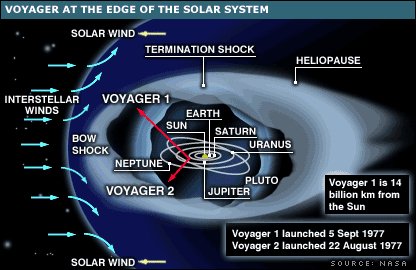|
|
’We’ve Stepped into the Galaxy;’ Voyager-1 Reaches Interstellar Space
13 September 2013
(LPAC)—Covering a distance of one million miles per day, and after 36 years, the Voyager-1 spacecraft has reached the end of the Solar System, and crossed over into interstellar space. At a distance from Earth of nearly 12 billion miles, the plasma wave instrument aboard the spacecraft has measured a change in plasma density, indicating that Voyager has left the heliosphere - -the region of interplanetary space where the plasma originates from the solar wind — and entered interstellar space, where the plasma originates from the explosion of stars. As the first manmade object to reach this milestone, Voyager will now give us our first in situ look at the Milky Way galaxy of which our Solar System is just one of many stars with planets. As Dr. Ed Stone, who led the Voyager project from its start, said at a NASA briefing this afternoon, it will help us answer the question: "What is beyond the planets?" Now, Stone stated, "we are setting sail in the cosmic seas between the stars." The plasma sensor aboard Voyager-1, that would have provided direct measurements of plasma density and temperature, failed in 1980. So the scientists relied on data from an indirect phenomenon, by detecting the plasma waves that are created periodically through the interplanetary medium by coronal mass ejections from the Sun. When the particles and magnetic fields generated by the solar outbursts arrived at Voyager, fully a year after the event on the Sun, the plasma started to vibrate, and the pitch of the radio vibrations helped scientists determine the density of the surrounding plasma. Measurements taken indicated that the plasma was more than 40 times denser than what they had measured in the outer layer of the heliosphere. This dramatic increase in density, the scientists agree, means the spacecraft has passed through the heliopause, the "long-hypothesized boundary between" the Solar System and galactic space. As for some of the science that lies ahead, Dr. Gary Zank, from the University of Alabama at Huntsville, explained that the science of galactic cosmic rays will be a key area of study. The spacecraft is now in a region where the cosmic rays are largely "unmodulated" (unaffected) by the solar wind. By the same token, "some momentum and energy of the solar wind are deposited in the interstellar medium," but Voyager should be able to make a comparative examination of cosmic rays inside and outside the Solar System. Voyager-2, which was actually launched a few weeks before Voyager-1, in 1977, is expected to arrive in a different region of interstellar space, in perhaps three years. [MGF] |



